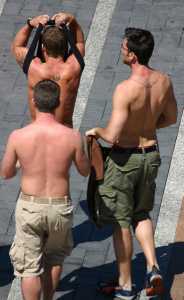07 Dec Current Sunscreens Lack Protection Against Damaging Effects of Visible Light
MedicalResearch.com Interview with:
Prof. Dr. Mauricio S. Baptista
Chemistry Institute (IQ-USP)
University of São Paulo
Brazil
 MedicalResearch.com: What is the background for this study? What are the main findings?
MedicalResearch.com: What is the background for this study? What are the main findings?
Response: This research started around 7 years ago. Our lab had a lot of previous experience in studying how photosensitizers (molecules that absorb light and transfer energy to others in its surroundings) used for Photodynamic Therapy, behave in the intracellular environments. We realized that most scientific work that defined the effects of sun in skin did not really consider looking into the properties of the molecules that are naturally found in skin and that absorb light. We also realized that very likely natural photosensitizers present in the skin behaves similarly when excited by either UVA or visible light. It all depends on which molecule absorb light and how the subsequent excited states behave. The work started by looking at melanin and melanocyte cells (Chiarelli-Neto et al Free Radic Biol Med 2011, 51, 1195; Chiarelli-Neto O et al. PLoS ONE, 2014 9(11): e113266). More recently we start looking at keratinocytes and liposfucin (Tonolli et al Journal of Investigative Dermatology 2017, 137, 2447).
UVB has a very different effect in the skin compared to UVA and Visible, because UVB is absorbed directly by the DNA molecules of our skin cells, inducing some direct photochemical processes that form photoproducts and distort the structure of DNA, affecting its function. Therefore, the effect of UVB is a lot more intense than that of UVA and Visible. However, our skin has a natural protection against it. Melanin and also the redness in the skin of people that do not have enough of melanin in the skin to support UVB radiation (getting red is the consequence of an acute inflammatory reaction, the signal for the person to leave the place). UVA does not excite directly DNA, but instead it acts by the phenomenon of photosensitization, in which the chromophore absorbs a photon and transfer its energy to the surrounding molecules forming either singlet oxygen (excited state of oxygen) or radical species.
The main finding is that UVA and visible light acts similarly when interacting with biological tissues. The consequence of these reactions is that they can cause photooxidation of DNA, forming pre-mutagenic DNA lesions, which can accumulate and cause malignant transformation. Our work has shown that visible light are also able to generate the pre-mutagenic DNA lesions similarly to the UVA light.
MedicalResearch.com: What should clinicians and patients take away from your report?
Response: Good sunscreens available today allow photons in the visible range to freely penetrate the skin, causing deleterious effects similar to those caused by UVA.
Therefore, the habit of using sunscreen and staying under the sun for long periods of time can cause irreparable damages to the health of the skin, including photo-aging and possibly the formation of tumors. People going to the beaches should use physical means to protect from the excess of irradiation, i.e., use shirts, hats, try to avoid direct sun exposition by staying in the shadow. The ideal routine for an individual that does not have skin sensitivity is the old recipe of exposing to the sun for a short time without external protection. In doing so one gets the benefits of the sun, for example, activation of vitamin D, without suffering the risk that prolonged exposure offers, even with the use of current sunscreens. Those who have had previous hypersensitivity problems in the skin, should avoid contact with sun light by physical means such as clothing, because the use of sunscreen only, will not be enough. For those that also mind about the beauty of hair, excess of sun exposure should be avoided for the same reasons before mentioned. The recently-developed hair products that have sunscreen included in its formulation, will not help much, because hair bleaching is mainly caused by visible light.
MedicalResearch.com: What recommendations do you have for future research as a result of this study?
Response: When the subject is light interaction with tissues, I always recommend researchers should initially look into which molecules are absorbing light instead of trying to simply and directly measure the consequences of light exposition.
MedicalResearch.com: Is there anything else you would like to add?
Response: I am an University professor with no commercial link to any company or institution, besides my job at USP, which is a public-funded University. Therefore, I have no disclosures or conflict of interests. Besides studying the effects of visible light, we are also studying possible ways to protect against its effects. Indeed, we are developing new concepts for sun protection, including nanoparticles modified with thin films of melanin (patent application MIRANDA & BAPTISTA, INPI 2016 BR1020160242622), and carbohydrates that confer membrane protection (RODRIGUES, D et al. Photochem. Photobiol. Sci.2016, 15, 334-350)
MedicalResearch.com: Thank you for your contribution to the MedicalResearch.com community.
Citation:
Paulo Newton Tonolli, Orlando Chiarelli-Neto, Carolina Santacruz-Perez, Helena Couto Junqueira, Ii-Sei Watanabe, Felipe Gustavo Ravagnani, Waleska Kerllen Martins, Maurício S. Baptista. Lipofuscin Generated by UVA Turns Keratinocytes Photosensitive to Visible Light. Journal of Investigative Dermatology, 2017; 137 (11): 2447 DOI: 10.1016/j.jid.2017.06.018
Note: Content is Not intended as medical advice. Please consult your health care provider regarding your specific medical condition and questions.
[wysija_form id=”1″]
Last Updated on December 7, 2017 by Marie Benz MD FAAD

